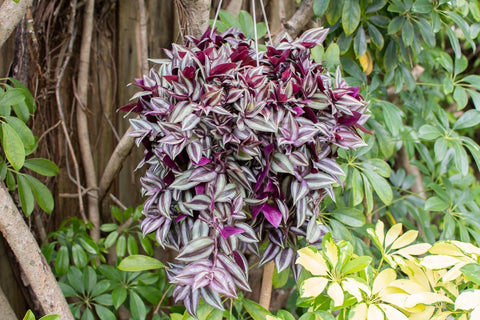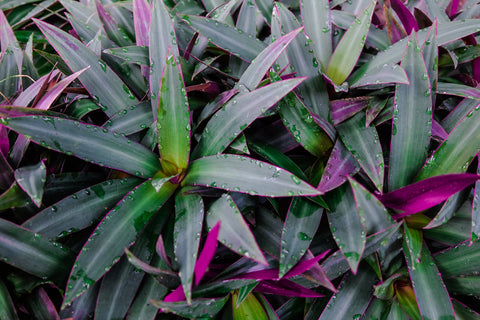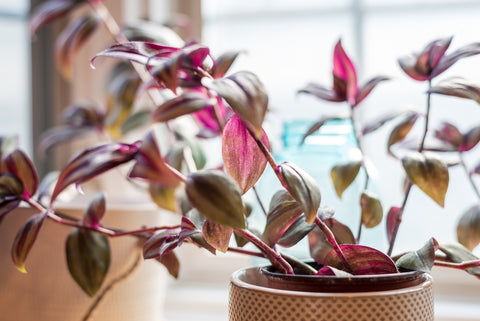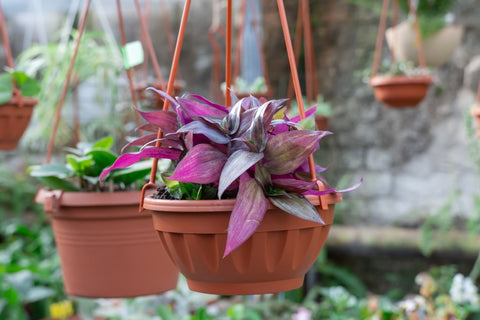• The Wandering Jew - An Introduction

Wandering Jew, also called the Inch plant, can be credited for starting the whole trend of plant swapping. Years before indoor plant gardening became a profitable business, friends, family, and fellow plant parents swapped cuttings of the Wandering Jew.
The Wandering Jew is native to tropical and temperate climates and grows vigorously with very little care. In fact, the name Wandering Jew comes from the fact that if the plant is left to its devices in the open, the plant will grow invasively to wander the ends of the earth.
Tradescantia Zebrina, earlier known as Zebrina Pendula, is a species of creeper loved across the globe for its bright purple foliage. When grown indoors in planters, the tradescantia can be grown all year round in home gardens, even by gardeners who have no real gardening experience.
☆ Common names

Inch plant, Spiderwort, Wandering jew, Wandering zebrina, Zebra plant
• Types of Inch Plants
This beautiful plant has over 70 popular varieties and more often than not you can find most of these varieties in your neighborhood growing with abandon in either hanging plants or as ground cover. Some of the most common tradescantia varieties are:
1. Tradescantia Fluminensis
This variety has fleshy ovate leaves with white and green variegations attached to fleshy stems. It has triangular white flowers with three petals.
2. Tradescantia Zebrina

The variegated leaves resemble the stripes of a zebra, the purplish-green leaves have a silver edge. One of the hardiest and quickest growing wandering jew varieties.
3. Tradescantia Pallida
Also famous as the Purple heart plant for its deep purple foliage and light purplish-pink flower. It stands out amazingly both as ground cover and as hanging plants.
Tradescantia blossfeldiana: The thick green leaves have a fuzzy texture with a white and green variegated upper side and a purple underside. The plant has clusters of beautiful blue, purple, white, and pink flowers.
4. Tradescantia Sillamontana
This plant has beautiful symmetry with leaves growing on thick succulent-like stems covered in white fuzzy hair. It produces magenta flowers in season.
5. Tradescantia Spathacea

Also famous as ‘moses in a blanket’, ‘oyster plant’, or ‘boat lily’, it's almost succulent like in nature. It has dark green leaves with purple underside growing in spiral patterns
• Wandering Jew (Tradescantia) Plant Care
The Wandering Jew plant is easy to grow in Indian climates and can add beautiful color to any home garden. A great plant for new plant parents, it is a joy to grow. Let’s take a look at the detailed guide for creeping inch plant care.
Spiderwort plants are mostly carefree. One of the only points of contention in growing this as a houseplant is getting the right moisture level.
1. Light

The creeping-Inch plants love bright indirect light but also do great with a few hours of direct light. Plant your wandering jew plant near a south-facing window where it can get at least 6 to 7 hours of bright indirect light. Growing your spiderwort in North-facing balconies and terraces is also a good idea.
If the colour or variegations on the leaves start to diminish then it is a clear sign of low light. Shift your plant to an area with brighter light conditions.
2. Water

The wandering jew plant likes its potting mix to be kept uniformly moist at all times but not soggy at all. Under indirect light conditions, water your wandering jew plant once per week or when the top soil dries out. Don't let the soil dry out completely.
However, when watering your dried potting mix, water it in batches to ensure that the soil absorbs all the water and it just doesn’t run out of the planter. Water a little and then wait for a while for the soil to soak up the water before watering it again till it drains out of the drainage hole at the bottom of the planter.
3. Soil
The creeping inch plant is not very finicky about the soil it grows in. It thrives in a well-draining but rich potting mix. The key points to be kept in mind is allowing the topsoil to dry in between waterings and also aerate the soil once in a while. Since the spiderwort plant loves moist potting mix, it is very important that it is well-draining and well-aerated so root rot can be avoided.
4. Fertilizers

Use a well-balanced and generic houseplant fertilizer for your wandering jew plant. They are not heavy feeders and do well with both root and foliar application every 15 days. Use a good quality fertilizer like the Ugaoo Plant Tonic for this. Dilute the fertilizer as instructed and apply directly to roots once in 15 days and put it in a misting spray and do a foliar application too once in 15 days. The foliar application guarantees bigger and showier leaves. However, don't overfeed the plant as it causes the leaves to lose their variegations.
5. Pruning

The Spiderwort plant does not require any pruning as such. Pruning for the creeping inch plant comes into play in two instances; one is to remove dead foliage and the other is to manage the shape and growth pattern of the plant. When left to its own devices, the spiderwort plant becomes leggy, to keep your plant fuller, prune the stems from time to time or pinch back at least one-fourth of the branch length.
Simply use sharp clean pruning shears or scissors to prune away stems at the required length, and cut at an incline in between leaf nodes.
To remove dead or yellowing leaves, just pinch it away ensuring the leaf stalk is also removed from the main stem.
Buy Pruning Shears
• Propagating Wandering Jew Plant
The easiest plant to propagate, the wandering jew can be propagated by anyone with a pair of scissors to take cuttings. Simply take 1 to 2-inch long cuttings of the plant, with at least 1 leaf node. Plant the cuttings in a moist potting mix or propagate in water. Keep the setup in a spot with bright indirect light.
• Problems With the Inch Plant and How to Deal with Them

Like many plants, the spiderwort can be plagued by aphids and spider mites. In case of infestation, spray the plant with neem oil solution to get rid of the pests and as preventive measures. In case of heavy infestations, prune away the infested parts.










